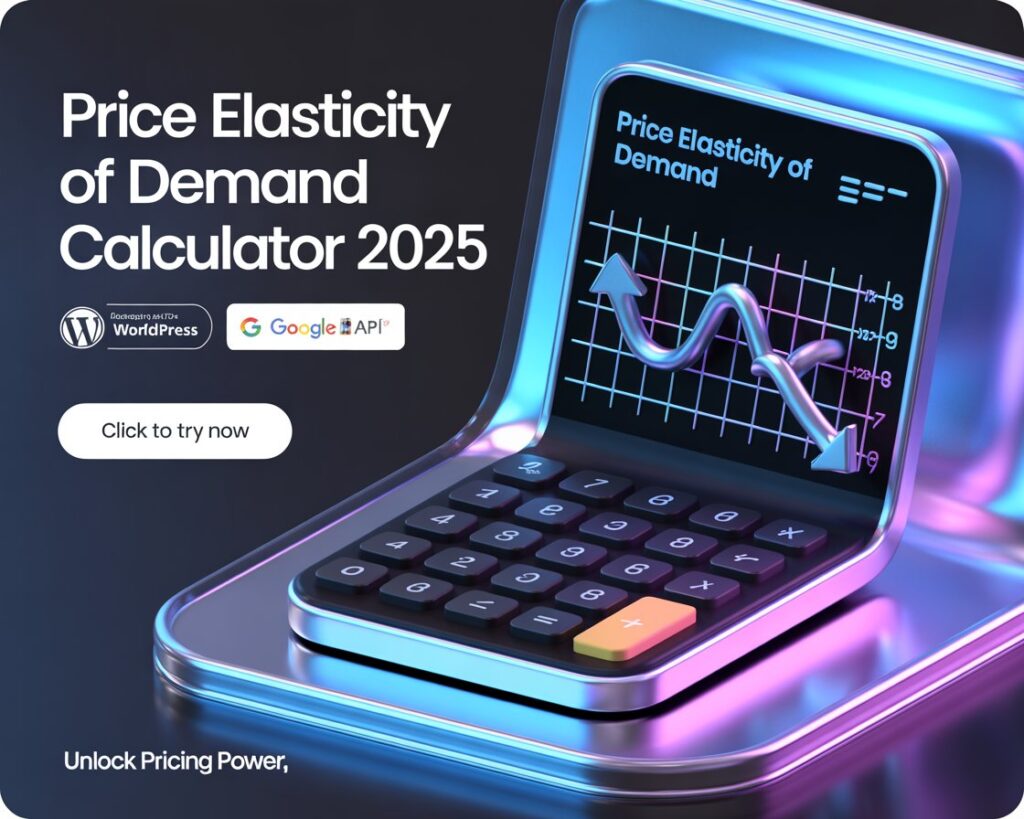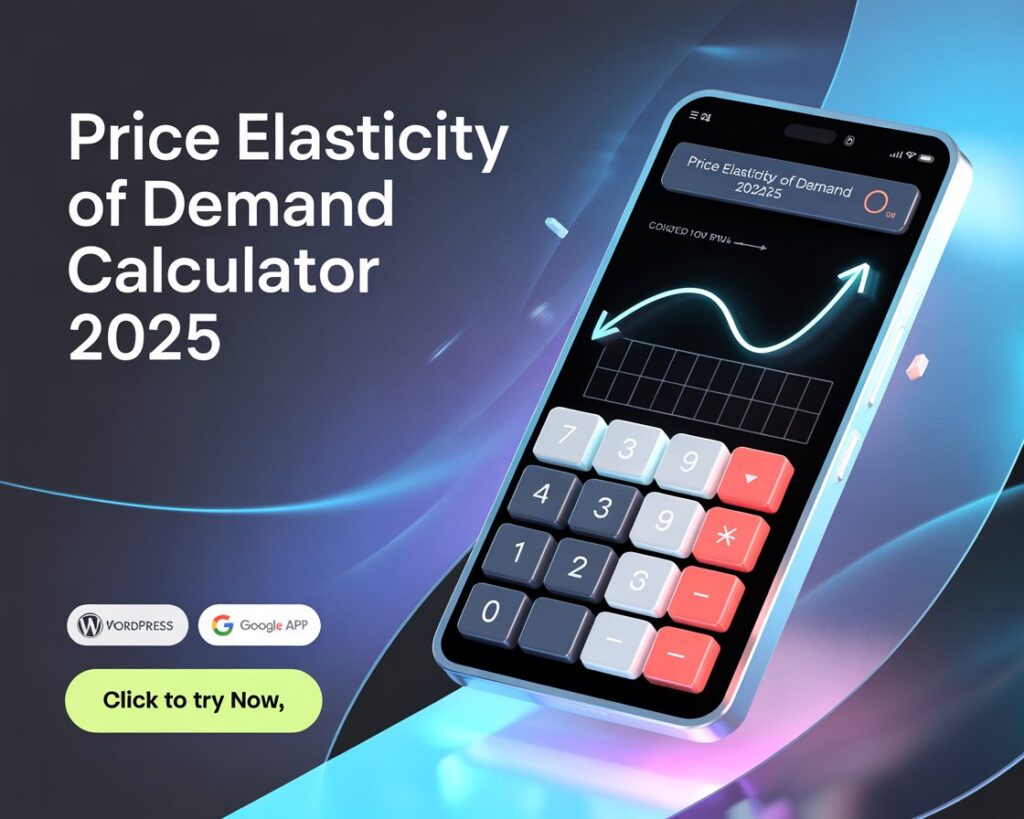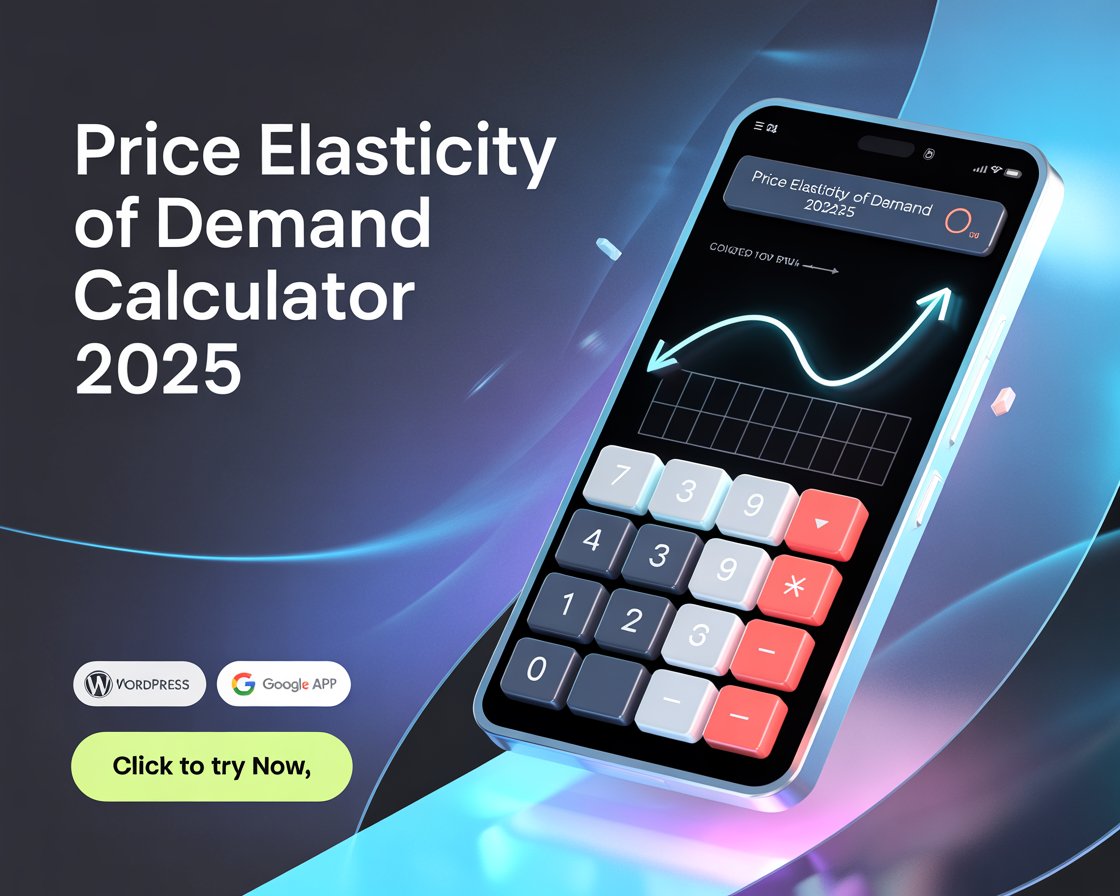Discover how the 2025 Price Elasticity of Demand Calculator simplifies economic analysis with real-world examples, trends, and tips.
Price Elasticity of Demand Calculator 2025
Calculate how quantity demanded responds to price changes with our interactive tool. Perfect for businesses, economists, and students.
Understanding Price Elasticity of Demand
Price Elasticity of Demand Calculator 2025: A Complete Guide for Students, Economists & Analysts

Understanding how consumers respond to price changes is essential in economics, marketing, and financial planning. The Price Elasticity of Demand (PED) measures that sensitivity, and in 2025, advanced tools like Price Elasticity of Demand Calculators make the process easier and more accurate.
In this comprehensive guide, we’ll break down:
- What price elasticity of demand means
- How the 2025 calculator works
- Who should use it and why
- Use cases, examples, and benefits
- Updated trends in demand analysis
- FAQs and actionable next steps
What Is Price Elasticity of Demand (PED)?
Price Elasticity of Demand (PED) refers to the percentage change in quantity demanded in response to a percentage change in price. It helps economists, analysts, and marketers predict consumer behavior when prices fluctuate.
PED Formula: PED=% Change in Quantity Demanded% Change in Price\text{PED} = \frac{\%\ \text{Change in Quantity Demanded}}{\%\ \text{Change in Price}}PED=% Change in Price% Change in Quantity Demanded
Types of Price Elasticity:
- Elastic Demand (PED > 1): Consumers are highly responsive to price changes.
- Inelastic Demand (PED < 1): Consumers are less responsive to price changes.
- Unitary Elasticity (PED = 1): Proportional response to price changes.

Why Use a Price Elasticity of Demand Calculator in 2025?
In 2025, demand analysis has grown beyond textbooks and spreadsheets. Real-time decision-making requires fast and precise tools. A PED calculator is a digital tool that automates the elasticity calculation using input values for price and quantity before and after change.
Key Benefits:
- 🚀 Time-Saving
- 📊 Accurate & Consistent
- 🧠 Better Decision Making
- 🧩 Data-Driven Forecasting
How the 2025 PED Calculator Works
The 2025 version of PED calculators is powered by AI and cloud computation, integrated into economic platforms like Statista, Tableau, and Google Sheets plug-ins.
Input Requirements:
- Initial Price (P1)
- New Price (P2)
- Initial Quantity (Q1)
- New Quantity (Q2)
Output:
- PED Value
- Interpretation (Elastic/Inelastic/Unitary)
- Graph Visualization (most tools)
- Recommendations (in premium versions)
Real-World Example
Let’s say:
- Old Price = $10
- New Price = $8
- Old Quantity = 100 units
- New Quantity = 140 units
PED=(140−100)/100(8−10)/10=0.4−0.2=−2\text{PED} = \frac{(140 - 100)/100}{(8 - 10)/10} = \frac{0.4}{-0.2} = -2PED=(8−10)/10(140−100)/100=−0.20.4=−2
Interpretation:
PED = -2 → Elastic Demand → Price drop significantly increased quantity demanded.

Top 5 Free PED Calculators in 2025
- Calculator.net PED Tool
- Omni PED Calculator
- RapidTables Demand Calculator
- iCalculator Economic Tools
- Google Sheets Elasticity Plug-in
Each provides input fields, step-by-step results, and educational support.
Who Should Use the PED Calculator in 2025?
🎓 Students
Perfect for economics homework, simulations, and thesis modeling.
🧑💼 Economists
Analyze market behavior, inflation impacts, or taxation implications.
💼 Business Analysts
Forecast sales outcomes, optimize pricing, or conduct competitive research.
🛒 E-Commerce & Retail Managers
Evaluate price change impacts on product sales and promotions.
Updated Trends in Price Elasticity Analysis (2025)
- AI-Powered Prediction Tools
Forecast elasticity before applying price changes. - Elasticity as a Service (EaaS)
APIs integrated into business dashboards to provide real-time elasticity data. - Mobile PED Apps
On-the-go tools for field researchers, accessible via smartphones. - Blockchain for Transparency
Elasticity results and price change data stored on-chain for audit trails. - Personalized Elasticity
Machine learning now allows for individual consumer-level elasticity predictions.
Use Cases for PED Calculators
| Use Case | Description | Benefit |
|---|---|---|
| E-commerce Pricing | Analyze seasonal demand vs. pricing | Higher sales, better margins |
| Tax Policy Analysis | Assess consumer response to taxes | Efficient policy planning |
| Marketing Strategy | Test discounts vs. customer response | Optimize conversion rates |
| International Trade | Compare elasticity across regions | Strategic export planning |
| Financial Reporting | Estimate future revenue impact | Accurate forecasting |
Pros and Cons
| Pros | Cons |
|---|---|
| Easy to use with instant results | May oversimplify complex markets |
| Improves accuracy over manual calculation | Requires accurate input data |
| Helps avoid costly pricing mistakes | Not always suitable for luxury or niche goods |
| Supports visual learning | Free tools may lack advanced features |

Frequently Asked Questions (FAQs)
Q1: What is a good PED value?
A good value depends on context. If you’re maximizing revenue, unitary elasticity (PED = 1) is ideal.
Q2: Can PED be positive?
Generally, no. But in rare cases (like Giffen goods), a positive PED may be observed.
Q3: Is PED the same as price sensitivity?
They are related. PED is the numerical representation of price sensitivity.
Q4: Are PED calculators reliable?
Yes, especially if input data is accurate. Advanced tools even offer insights.
Q5: What if I don’t have quantity data?
Some calculators allow for estimation based on percentage changes alone.
Conclusion
In 2025, staying competitive means embracing fast, smart tools. The Price Elasticity of Demand Calculator simplifies complex economic calculations, making it a must-have for students, analysts, and business leaders alike. Whether you're evaluating discounts, forecasting revenue, or analyzing markets, this tool gives you clarity and confidence.
Call to Action
🎯 Ready to make smarter pricing decisions?
👉 Try a Free Price Elasticity of Demand Calculator today!
Or embed one in your business dashboard using Elasticity API tools now available on platforms like Zapier and Google Workspace.
